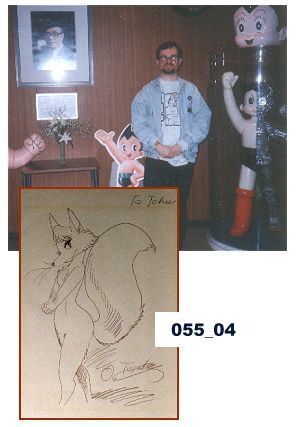cataroo.com
Home of John Cawley
Dedicated to My Wife & Times - A Site for Sore Eyes
Back To Archives
Back To Main Page
|
Frames of Time... 055_04 - Tezuka: The Father of Anime Tezuka's library of characters is truly astounding from the perpetual Astro Boy and Kimba to the lesser known Black Jack, Unico, and Vampyre. Tezuka's output of characters should earn him a position in the Guinness Book of World Records. He created for TV, theaters and even festivals. His name (and fame) eclipsed by modern creators like Miyazaki, Tezuka's legacy remains via such recent blockbusters as PHOENIX 2772 and the new ASTRO BOY series. (Many of Anime's main themes and concepts can be traced back to Tezuka's work.) My introduction to Tezuka was in the mid 1970s. I had gotten involved with the Cartoon Fantasy Organization (aka CFO). This local group of animation fans gathered once a month to watch videotapes, usually of Japanese animation. Ironically, the group grew out of the "Kimba Club". (More on both groups a later day.) Pre-dating the Anime revolution of the 1990s, the CFO introduced many up and coming animation and comic pros to Japanese animation. A friend of mine was a big fan of Tezuka and wanted to correspond with him. Not a writer, they asked if I'd help draft letters and I said yes. (I've ghosted letters for many folks, from Disney Execs to Don Bluth.) We would write letters and Tezuka would graciously respond. He often sent back videotapes of new productions. I soon became a fan myself, amazed at the depth of his character creation. I finally got to meet the master at the San Diego Comic Con. The Japanese Cultural department had sent a batch of Japanese cartoonists and illustrators to the con as a "cultural exchange" event. I bumped into him in the dealers room. As always, he wore the little beret that seemed as much of him as his glasses. We chatted briefly. Since I was introduced as someone who worked in the Walt Disney Studio Archives, he was particularly interested and we discussed Disney history and the influence it had on his work. He was carrying a sack of some of his manga and asked if I wanted anything from him. I told him I did not collect manga and to save them for his fans who would enjoy it more. He smiled and asked if I liked anything. I said I collected foxes. In an instant he pulled out paper and did the vixen you see above. As things happened, I didn't have any further contact with Tezuka for several years. It happened while I was working on development at Film Roman in the late 1980s. We thought it was a perfect time to revive Astro Boy. Oddly, I still had Tezuka's fax number in my book. Not certain it would work, we wrote a quick note suggesting the idea and added a drawing of a Garfield-style Astro Boy. The next day we got a return fax with a quickly hand written note. It stated Tezuka was highly amused by the illustration. It also stated that Tezuka did not want to do any co-productions with the U.S. using his characters. Tezuka died in 1989. When I took my trip to Japan, I was able to make a stop at the Tezuka studio. They had maintained Tezuka's office as it had been when he was alive. It was fascinating to see the office, and see the many U.S. examples of comics and film on display. (It was a kind of a strange opposite to so many U.S. animators who filled their workspace with Anime images.) As expected the studio was full of memorabilia based on his creations. The studio was even working on a direct to video series featuring Tezuka's medical man, Black Jack. Like Walt Disney, Osamu Tezuka was a creative pioneer in an industry bursting with creative talent. Similar to Disney (and so many U.S. Disney wannabes), Tezuka was presented by his studio as a friendly, gracious gentleman. I was so pleased to find that in real life, Tezuka was as gracious and warm as his image had led me to believe.
Back To Archives Back To Main Page |
 Dr. Osamu Tezuka is one of the most influential talents in animation. During the 1970s and 1980s, he was oft referred to as the "Disney of Japanese animation". (Ironic since he was born in 1928, the same year as Mickey Mouse.) True to that claim, his groundbreaking work and phenomenal achievements in manga and animation laid the basis for modern Anime, Manga, and even U.S. animation.
Dr. Osamu Tezuka is one of the most influential talents in animation. During the 1970s and 1980s, he was oft referred to as the "Disney of Japanese animation". (Ironic since he was born in 1928, the same year as Mickey Mouse.) True to that claim, his groundbreaking work and phenomenal achievements in manga and animation laid the basis for modern Anime, Manga, and even U.S. animation.